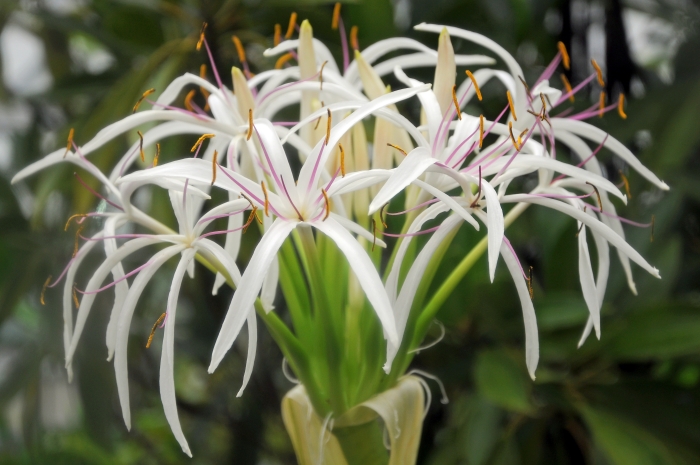Poisonbulb
(Crinum asiaticum)
Poisonbulb (Crinum asiaticum)
/
/

Amada44
CC BY 3.0
Image By:
Amada44
Recorded By:
Copyright:
CC BY 3.0
Copyright Notice:
Photo by: Amada44 | License Type: CC BY 3.0 | License URL: https://creativecommons.org/licenses/by/3.0 | Uploader: Amada44 | Publisher: Wikimedia Commons | Title: Crinum_asiaticum_003.jpg |










































































Estimated Native Range
Summary
Crinum asiaticum, commonly known as Poisonbulb, is an evergreen perennial herb native to coastal areas, wetlands, and open woodlands of tropical Asia, Australia and the Pacific Islands. It typically grows to a height and width of 4-6 feet (1.2-1.8 meters). This plant features large, strap-like leaves and clusters of fragrant, white to pale pink flowers that bloom intermittently throughout the year, with peak flowering in the summer. The flowers are showy and can add an exotic touch to gardens.
Poisonbulb is valued for its lush foliage and striking, fragrant flowers. It is often used in tropical and subtropical landscapes as a specimen plant, in borders, or as a naturalizing element in wet areas. It thrives in full sun to part shade and prefers moist, well-drained soils, but can tolerate a range of soil conditions. While it is generally low-maintenance, it can be susceptible to spider mites and mealybugs. In regions where it is not invasive, it can be a beautiful addition to water gardens or pond margins. However, it is important to be aware of its potential invasiveness and toxicity; all parts of the plant are poisonous if ingested.CC BY-SA 4.0
Poisonbulb is valued for its lush foliage and striking, fragrant flowers. It is often used in tropical and subtropical landscapes as a specimen plant, in borders, or as a naturalizing element in wet areas. It thrives in full sun to part shade and prefers moist, well-drained soils, but can tolerate a range of soil conditions. While it is generally low-maintenance, it can be susceptible to spider mites and mealybugs. In regions where it is not invasive, it can be a beautiful addition to water gardens or pond margins. However, it is important to be aware of its potential invasiveness and toxicity; all parts of the plant are poisonous if ingested.CC BY-SA 4.0
Plant Description
- Plant Type:
- Height: 4-6 feet
- Width: 4-6 feet
- Growth Rate: Moderate
- Flower Color: White
- Flowering Season: Summer, Fall
- Leaf Retention: Evergreen
Growth Requirements
- Sun: Full Sun, Part Shade
- Water: Medium
- Drainage: Fast, Medium, Slow
Common Uses
Bee Garden, Butterfly Garden, Drought Tolerant, Fragrant, Showy Flowers, Water Garden
Natural Habitat
Coastal areas, wetlands, and open woodlands of tropical Asia and the Pacific Islands
Other Names
Common Names: Giant Crinum Lily, Grand Crinum Lily, Spider Lily, Asiatic Poisonbulb, 文珠蘭
Scientific Names: , Crinum asiaticum, Crinum taitense, Bulbine asiatica, Crinum brevifolium, Crinum canaliculatum, Crinum macrocarpum, Crinum pedunculatum subsp. pacificum, Crinum sumatranum, Crinum tocicarum
GBIF Accepted Name: Crinum asiaticum L.